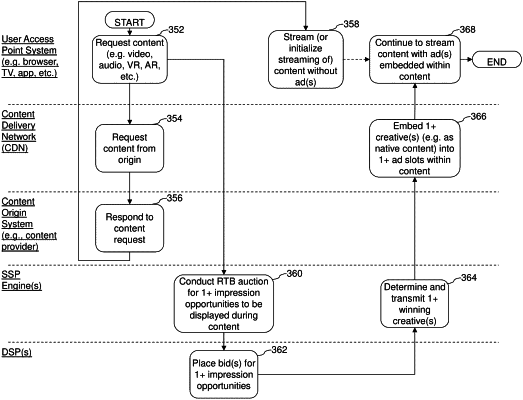| CPC G06Q 30/0257 (2013.01) [G06F 21/6263 (2013.01); G06Q 30/0275 (2013.01)] | 20 Claims |

|
1. A system for reducing latency in rendering user-requested content on a user access point system, the system comprising:
one or more computer readable storage devices configured to store a plurality of computer executable instructions; and
one or more hardware computer processors in communication with the one or more computer readable storage devices and configured to execute the plurality of computer executable instructions in order to cause the system to:
receive a request from a user access point system and/or a content origin system to transmit user-requested content to the user access point system;
transmit the user-requested content to the user access point system, wherein the user-requested content comprises one or more placeholders for one or more user-targeted advertisements, thereby allowing the user access point system to render the user-requested content without the one or more user-targeted advertisements, wherein advertisers do not have access to the user access point system, thereby decreasing latency in rendering user-requested content;
initiate an advertisement selection process for determining the one or more user-targeted advertisements for placement in the user-requested content, wherein the advertisement selection process is processed asynchronously and in parallel to the transmission of the user-requested content, wherein the advertisement selection process is processed wholly outside of the user access point system, wherein initiating the advertisement selection process comprises:
retrieving or generating a common user identifier for a user of the user access point system;
generating a request to conduct the advertisement selection process;
embedding the user identifier into the request to conduct the advertisement selection process; and
transmitting the request to conduct the advertisement selection process to a supply-side platform for conducting the advertisement selection process, wherein the supply-side platform is configured to utilize the common user identifier to dynamically conduct the advertisement selection process, wherein the supply-side platform translates the common user identifier, using a graph data structure, into a user identifier used by a demand side platform or data management platform as part of the advertisement selection process;
receive, from the supply-side platform, a selection of the determined one or more user-targeted advertisements for placement in the user-requested content; and
transmit, to the user access point system, the determined one or more user-targeted advertisements, wherein transmission of the determined one or more user-targeted advertisements causes placement of the determined one or more user-targeted advertisements in the one or more placeholders of the user-requested content subsequent to transmission of the user-requested content, thereby reducing latency in rendering the user-requested content on the user access point system.
|